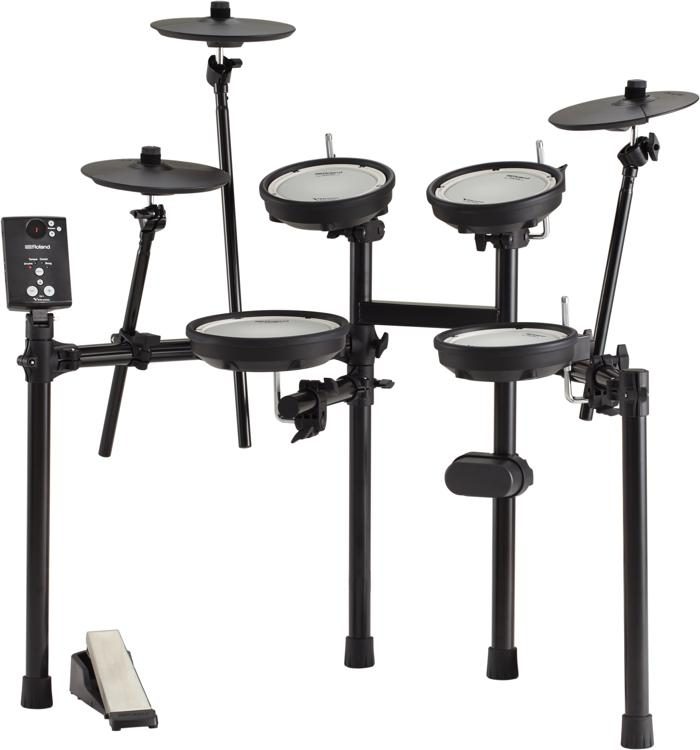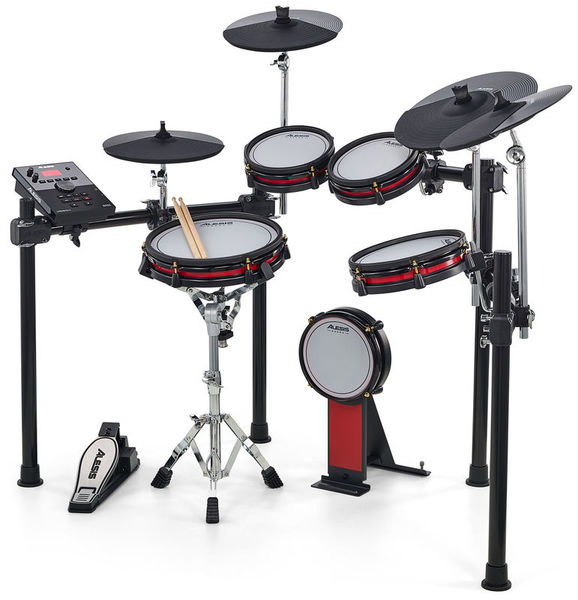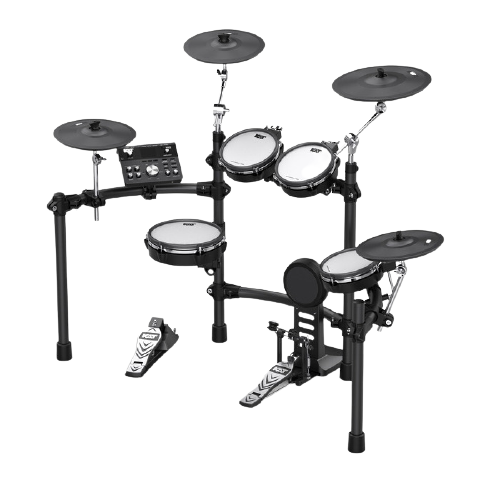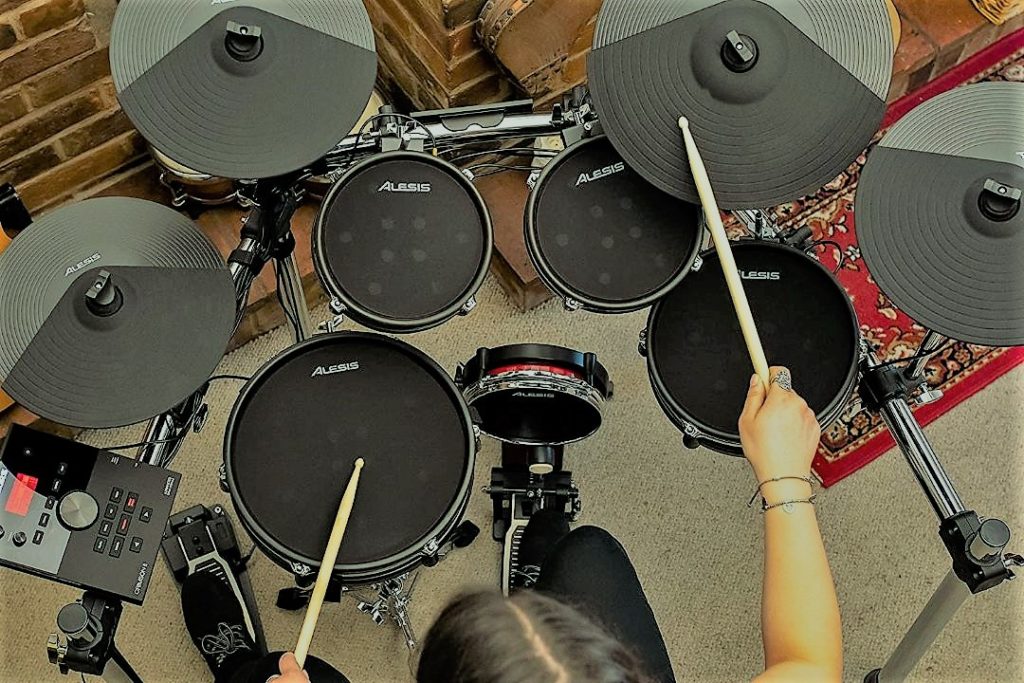Is the best budget electronic drum kit within your budget any good? Let’s analyze the options and find out.
Luckily, I am one of those drummers that can play 12h a day and not get a single complaint from the neighbors. That’s my experience from the past 20+ years at least, hopefully, it doesn’t change now.
Either way, I know well enough that most drummers are not as lucky as I am, and they either don’t practice when they want, take advantage of the practice pad or invest in an electronic drum kit.
As of today, an electronic drum kit might be the perfect solution to avoid disturbing your family members, roommates, or neighbors.
All you have to do is to connect a pair of headphones to the drum kit and suddenly you’re the only one able to hear it. Well, you can still hear the rubber and mesh sounds, but you know what I mean.
They’re also useful if you want to record yourself playing without investing a lot in studio gear.
On top of that, with the number of sounds you can get out of an electronic drum kit when compared to an acoustic drum kit, unleashing your creativity is easier than ever.
What are the limitations of an electronic drum kit?
Keep in mind that, no matter how good an electronic drum kit feels and sounds, it still doesn’t replace the authenticity of an acoustic kit.
On the other hand, electronic drum kits improved substantially in the past decade or two, which guarantees that nowadays, even the budget ones are good enough to practice, and sometimes, perform with.
Just like with any piece of technology, shopping for an electronic drum kit can be daunting, considering all the different brands, models, price ranges, and special features.
When it comes to budget electronic drum kits, their limitations include:
- fewer drum and cymbal pads;
- fewer zones on drum and cymbal pads;
- inability to choke cymbals;
- lower-quality materials;
- inability to expand the drum kit.
What to look for in an electronic drum kit?
Despite those limitations, there are a couple of things that no one should go without. The first one is mesh heads. They are far superior to rubber ones since they provide the closest feeling to a regular drum head.
The second one is a bass drum tower with a bass drum pedal. Cheaper models tend to use a trigger that works similarly to the press of a button. That doesn’t contribute at all to the development of your feet’ speed and coordination.
On that note, avoid any electronic drum kit with rubber pads and triggers pedals. In this day and age, there’s no reason to play with any of those.
If you’re looking for more advanced features and extra versatility, take a look at MY GUIDE about the best electronic drum sets.
Everyone has their definition of budget, but I think we can all agree that as far as electronic drum kits go, anything under $1000 is considered budget.
I’ll go into detail about what makes them the best within your budget, their pros, and cons, and hopefully answer some questions you might have.
With that in mind, here are the best budget electronic drum kits on the market:
 Specifications:
Specifications:
- 8″ Dual-zone snare drum pad
- 8″ Single-zone tom pads x 3
- 10″ Single-zone cymbal pads (one with stop function) x3
- Bass drum pad
- Bass drum pedal
- Hi-hat controller
- Drum Module
- Drum rack
- Cabling
- Drumsticks
When it comes to the best budget electronic drum kit that doesn’t cost an arm and a leg, the Nitro Mesh Kit is always my first suggestion.
This set comes with one 8” dual-zone drum pad that acts as your snare. Since it’s dual-zone, hitting the mesh head or the rim triggers different sounds, just like it would happen with an acoustic snare.
Additionally, there are three 8” pads similar to the snare one, but unfortunately, they’re single-zone, and therefore, they only trigger one sound at a time.
On top of that, the Alesis Nitro Mesh Kit features a bass drum tower that works with any regular bass drum pedal, including double bass drum pedals.
That’s one of the things I advise everyone to look for in an electronic drum kit, which makes this set way ahead of most budget options.
As far as pads go, the package is completed with three single-zone cymbal pads – Hi-Hat, Crash, and Ride. You can choke the crash one, which means you can simply grab it to stop the sound.
Both Hi-Hat trigger pedal and bass drum pedal are included with the kit. Plus, a four-post aluminum rack, cables, power supply, and a drum module.
Aimed for beginners, as a welcoming gift, Alesis includes a drum key to adjust your mesh drum head’s tension and a pair of drum sticks.
Nitro Drum Module
The module itself comes with four preset kits, sixty play-along tracks, and hundreds of percussion sounds.
On the back you find a USB/MIDI connection to trigger virtual instruments and record yourself. Plus, a headphone jack to practice in silence and stereo outs to connect to an amp.
One of my favorite parts of the Alesis Nitro Mesh Kit is the ability to expand it using the extra Tom 4 and Crash 2 trigger pad inputs on the back of the drum module.
If you’re interested in expanding it, you can do so with the “Alesis nitro expansion pack” that includes the original extra tom and cymbal pad and costs around $100.
What could be improved?
Considering how much you get for such a ridiculously low price, it’s hard to point any negative aspects.
Still, for me, its weakest points are the low number of dual and triple-zone pads (zero, when it comes to triple-zone) and the quality of the samples included with the drum module being far from good.
Besides that, I honestly believe this is the best budget electronic drum kit for someone that’s either a beginner or has a tight budget.
 Specifications:
Specifications:
- PDX-8 Dual-Zone Mesh Head Snare Pad x1
- PDX-6A Single-Zone Mesh Head Tom Pads x3
- Crash CY-5 pad with stop function x1
- Ride CY-5 pad with stop function x1
- Hi-hat CY-5 pad x1
- Kick pad x1
- Hi-hat pedal x1
- Drum Rack
- Cabling
- Drumsticks
When it comes to electronic drum kits, most people agree that Roland is one of the best, if not the best. Especially considering their flagship models.
Since most drummers can’t afford those models, at least without budgeting for a while, investing in Roland’s V-Drums entry-level model is always a good decision.
The TD-1DMK configuration is the same found in most budget kits, with three cymbal pads and five drum pads.
The PDX-8 snare pad has an 8” dual-zone 2-ply mesh head, which means you can trigger different sounds using the head or the rim.
All your toms are 2” smaller than your snare and consist of a 2-ply single-zone PDX-6A drum pad.
Every drum pad I just mentioned is tunable with a regular drum key so you can easily control the amount of rebound.
Additionally, the kick pad is wide enough to comfortably use any double bass drum pedal currently on the market.
As far as cymbals go, the TD-1DMK comes with three CY-5 cymbal pads. They are 10” each, and the ones used as a crash and ride are dual-zone (bow and edge). The Hi-Hat one detects three different positions: open, half-open, and closed.
Unlike some of the previous alternatives, even though it works with a regular bass drum pedal, it isn’t included with the kit.
On the other hand, it features a sturdy and easy-to-set-up drum rack, and Hi-Hat trigger pedal as well as a versatile drum module.
TD-1DMK Module
In terms of connectivity, the model includes a headphone jack and a USB port. You can use it to connect to your pc and trigger virtual instruments.
The drum module has 15 different drum kits, 15 play-along, and 10 coach functions including tempo check, timer, and recording.
One of my favorite parts of the whole kit is the bass drum pad, that’s not only wide but it’s also attached to one of the drum rack’s legs.
That guarantees it won’t move at all while playing, which is a common problem with cheap electronic drum kits.
What could be better?
It’s pretty hard to find anything negative about the Roland V-Drums TD-1DMK, especially considering its price. On that note, I wish that at least the three tom drum pads were dual-zone, which would add a new layer of versatility to this compact e-drum kit.
Expanding the TD-1DMK is also a possibility, but to my surprise, the drum module only allows one additional cymbal. Considering the Nitro Mesh Kit that costs 50% less can take up to two additional pads, the TD-1DMK expandability is a huge disappointment.
All in all, if you’re a drummer that values build quality and reliability, under $1000 no one beats Roland.
 Specifications:
Specifications:
- 12″ Dual-Zone Mesh Head Snare Pad
- 8″ Dual-Zone Mesh Head Tom Pad x2
- 10″ Dual-Zone Mesh Head Tom Pad
- 8″ Mesh Head Kick Pad
- 12″ Dual-Zone Hi-Hat Pad
- 12″ Dual-Zone Crash Cymbal Pads (with stop function) x2
- 14″ Triple-Zone Ride Cymbal Pad
- DMHat Pedal
- Chrome Rack
- Snare Stand
- Crimson II Sound Module
- Cabling, drumsticks and drum key
My next suggestion is another budget-friendly Alesis drum kit. If it’s your first time learning about electronic drum kits, you’ll soon realize that three or four manufacturers make the best drum kits, and Alesis is one of them.
The Crimson II comes with a 12” Dual-Zone Mesh Head Snare Pad. The fact that’s Dual-Zone and 4” bigger than the ones on the previous kits makes it the closest thing you can get to an acoustic snare drum on a budget.
On top of that, the three mesh-head tom pads are all dual-zone as well, and the floor tom is 2” bigger than the tom-toms. That might not look like much, but having a bigger floor tom adds another layer of realism.
The kick is just a basic 8” Mesh Head Kick Pad, large enough to accommodate single and double bass drum pedals.
Best cymbal pads under $1000?
When it comes to cymbals, they are the biggest selling point of the Alesis Crimson II.
First, there are more of them when compared to the previous budget electronic drum kits. The Crimson II features two crashes, a ride, and a hi-hat.
But, there’s more to it than the number of cymbals. The Hi-Hat is dual-zone (bow and bell) and the same happens with both crashes (able to be chocked).
My favorite part of the Alesis Crimson II is the 14” triple-zone ride (bell, bow, and edge), which is like nothing we’ve seen before on a budget electronic drum kit.
If that wasn’t enough already, the snare pad isn’t clamped to the rack either. Instead, it has its snare drum stand, also included with the kit.
Between that, the bigger tom and cymbal pads with additional hit-zones, switching from an acoustic to an electronic drum kit will be a piece of cake.
On top of that, the kit comes with a hi-hat trigger pedal, a study chrome rack, and a drum module.
Crimson II Module
The module features 74 kits (54 factory and 20 user) created with the 671 sounds it comes with. You can use the USB port to load samples with a USB memory stick, and the USB/MIDI output to trigger virtual instruments or record the drum kit.
To practice without disturbing your family members and neighbors, you can use the headphone jack to connect a pair of headphones. Otherwise, you can use the ¼” jack outputs to connect it to speakers or a mixer.
In conclusion, this is probably as far as your money can stretch when it comes to budget electronic drum kits. It offers the best value for the money of any kit under $1000.
 Specifications:
Specifications:
- 10″ Dual-Zone Mesh Head Pad
- 8″ Dual-Zone Mesh Head Pad x3
- 12″ Dual-Zone Cymbal Pad (with stop function) x3
- 14″ Triple-Zone Cymbal Pad (with stop function)
- 12″ Single-Zone Cymbal Pad
- 9″ Kick Tower Pad
- Bass Drum Pedal
- KT-300 USB Sound Module
- Hi-Hat Trigger Pedal
- Cabling
- Drum Rack
- Drum Key
KAT Percussion is somehow less popular than Alesis or Roland, but they were one of the first electronic percussion companies.
The KT-300 is the newest addition to their line of electronic drum kits, and one every drummer should take into consideration.
First, this kit comes with a 10” dual-zone mesh-head snare pad. It’s not as big as the Crimson II one, but it’s good enough for most people.
Every tom-tom and floor tom consists of an 8” dual-zone mesh head tom pad, and in this case, we got three of them.
As far as mesh heads go, they are made in collaboration with REMO and KAT claims they should endure well over 1 million strokes. They also change tone based on where you strike them and give a realistic feel to your playing.
The bass drum consists of a 9” kick tower pad with shock absorption, big enough to be used by any metalhead while disturbing as little as possible.
KT-300 Cymbals
Additionally, the biggest selling point of the KT-300 is its cymbals. First, all cymbals besides the ride are 12” and dual-zone (excluding the Hi-Hat).
On top of that, you can choke both crashes, which is something that distinguishes the beginner from the intermediate electronic drum kits.
The ride is a 14” triple-zone pad that you can choke, and therefore, hitting the bell, bow, and edge produce different sounds.
All the cymbal pads are 100% rubber, unlike most pads in the budget category that are usually half rubber and half plastic.
The kit is complete with a sturdy and spacious drum rack, a bass drum pedal, a hi-hat trigger pedal, and the KT-300 drum module.
KT-300 Module
KAT Percussion was never known for its hardware since its main focus is quality drum modules.
This one in particular features 38 drum kits (30 preset and 18 user), 270 percussion sounds, and coach functions to train your accents and timing.
On top of that, you’re able to play along tracks and record your sessions to evaluate your progress, as well as connect it using the USB/MIDI port.
There’s also a headphone jack, and as far as expanding the kit goes, there’s only a single TOM4 port and that’s it.
If you’re not satisfied with a specific sound, use one of the knobs to change the reverb, compression, tune, and EQ to make it your own.
All in all, this is a fantastic piece of technology, well worth the $1.000 it’s usually sold for. But, to be completely honest, if $1.000 was my max budget, I would pick the Alesis Crimson II any day of the week.
Wrapping up
When the budget is this low, you often skip things like the build quality, the drum and cymbal pads feel, as well as quality stock sounds the drum module comes with.
Entry-level electronic drum kits improved a lot recently, making them as good as flagship electronic drum kits from a decade ago.
They now have mesh heads instead of rubber ones, better drum sounds, and multiple-zones cymbals.
With that in mind, if your goal is to spend the least amount of money possible on an electronic drum kit, make sure you don’t buy anything worse than the Alesis Nitro Mesh Kit.
In my honest opinion, even with such a low budget, investing in an electronic drum kit with rubber pads and a trigger bass drum pedal is not worth it.
Sure, you might save a couple of dollars, but since that technology is way past its time and makes the whole kit less realistic, you lose more than you gain with it.
On the other hand, if you’re budget is close to $1.000, my favorite electronic drum kit at the moment is, by far, the Alesis Crimson II.
It has everything a drummer needs and you won’t even max out your budget. That leaves enough room to invest in a decent bass drum pedal or drum throne. If you want to take a look at the best budget bass drum pedals, HERE’s my article on the subject.
The Roland TD-1DMK is a fantastic option if you want a ticket to the world of V-Drums and value build quality and reliability the most.
To conclude, I hope this article achieves its main purpose of educating you on what to look for in an electronic drum kit, and what is the best budget electronic drum kit within your budget.

